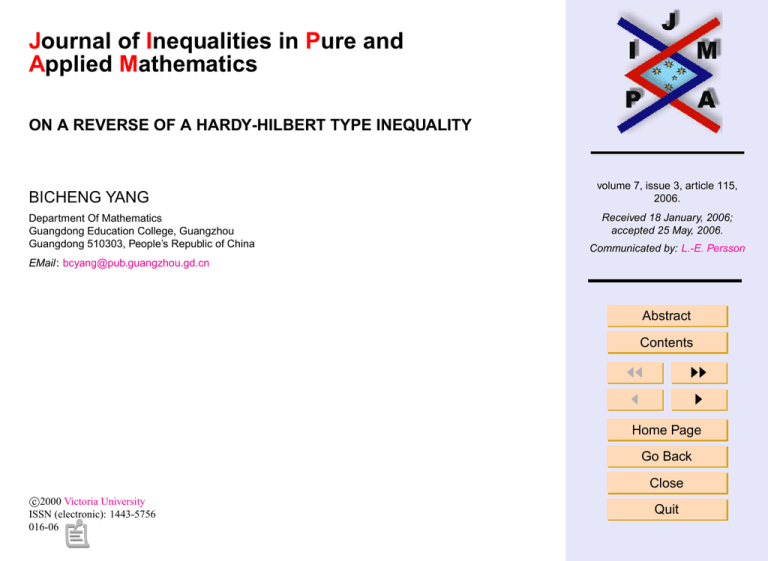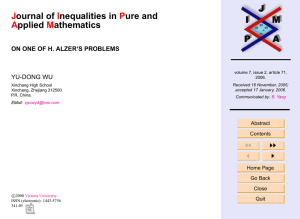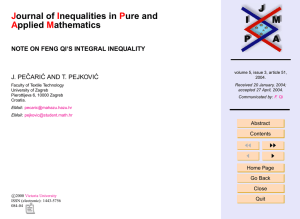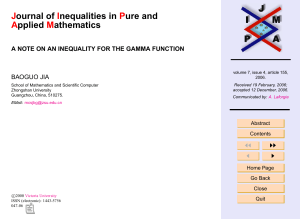J I P A
advertisement

Journal of Inequalities in Pure and
Applied Mathematics
ON A REVERSE OF A HARDY-HILBERT TYPE INEQUALITY
BICHENG YANG
Department Of Mathematics
Guangdong Education College, Guangzhou
Guangdong 510303, People’s Republic of China
volume 7, issue 3, article 115,
2006.
Received 18 January, 2006;
accepted 25 May, 2006.
Communicated by: L.-E. Persson
EMail: bcyang@pub.guangzhou.gd.cn
Abstract
Contents
JJ
J
II
I
Home Page
Go Back
Close
c
2000
Victoria University
ISSN (electronic): 1443-5756
016-06
Quit
Abstract
This paper deals with a reverse of the Hardy-Hilbert’s type inequality with a best
constant factor. The other reverse of the form is considered.
2000 Mathematics Subject Classification: 26D15.
Key words: Hardy-Hilbert’s inequality, Weight coefficient, Hölder’s inequality.
On a Reverse of a Hardy-Hilbert
Type Inequality
Research supported by Natural Science Foundation of Guangdong Institutions of
Higher Learning, College and University (China, No. 0177).
Bicheng Yang
Contents
Title Page
1
Introduction . . . . . . . . . . . . . . . . . . . . . . . . . . . . . . . . . . . . . . . . .
2
Some Lemmas . . . . . . . . . . . . . . . . . . . . . . . . . . . . . . . . . . . . . . .
3
Main Results . . . . . . . . . . . . . . . . . . . . . . . . . . . . . . . . . . . . . . . .
References
3
5
9
Contents
JJ
J
II
I
Go Back
Close
Quit
Page 2 of 16
J. Ineq. Pure and Appl. Math. 7(3) Art. 115, 2006
http://jipam.vu.edu.au
1.
Introduction
P∞ p
If p > 1, p1 + 1q = 1, an , bn ≥ 0, such that 0 <
n=0 an < ∞ and 0 <
P∞ q
n=0 bn < ∞, then we have the well known Hardy-Hilbert inequality (Hardy
et al. [1]):
(∞
) p1 ( ∞ ) 1q
∞ X
∞
X
X
X
π
am b n
<
apn
,
(1.1)
bqn
m+n+1
sin π
n=0 m=0
n=0
n=0
p
where the constant factor π/ sin(π/p) is the best possible. The equivalent form
is (see Yang et al. [8]):
p
!p
∞
∞
∞
X
X
π X p
am
(1.2)
<
an ,
m+n+1
sin π
n=0
n=0
m=0
On a Reverse of a Hardy-Hilbert
Type Inequality
where the constant factor [π/ sin(π/p)]p is still the best possible.
Inequalities (1.1) and (1.2) are important in analysis and its applications (see
Mitrinović, et al. [3]). In recent years, inequality (1.1) had been strengthened
by Yang [5] as
p1
∞ X
∞
∞
X
X
am b n
π − ln 2 − γ 1 apn
(1.3)
<
m + n + 1 n=0 sin π
(2n + 1)1+ p
n=0 m=0
Contents
p
p
1q
∞
X
π − ln 2 − γ 1 bqn
×
,
1+ q
π
(2n
+
1)
sin
n=0
p
Bicheng Yang
Title Page
JJ
J
II
I
Go Back
Close
Quit
Page 3 of 16
J. Ineq. Pure and Appl. Math. 7(3) Art. 115, 2006
http://jipam.vu.edu.au
where ln 2 − γ = 0.11593+ (γ is Euler’s constant). Another strengthened version of (1.1) was given in [6]. By introducing a parameter λ, two extensions of
(1.1) were proved in [8, 7] as:
(1.4)
∞ X
∞
X
am b n
(m + n + 1)λ
n=0 m=0
(∞ 1−λ ) 1q
1−λ ) p1 (X
∞ X
1
1
;
bqn
< kλ (p)
n+
apn
n+
2
2
n=0
n=0
On a Reverse of a Hardy-Hilbert
Type Inequality
Bicheng Yang
(1.5)
∞ X
∞
X
am b n
λ λ
<B
,
λ
(m
+
n
+
1)
p
q
n=0 m=0
(∞ (q−1)(1−λ) ) 1q
(p−1)(1−λ) ) p1 (X
∞ X
1
1
,
bqn
×
n+
apn
n+
2
2
n=0
n=0
q+λ−2
where, the constant factors kλ (p) = B p+λ−2
,
(2 − min{p, q} < λ ≤
p
q
2), and B λp , λq (0 < λ ≤ min{p, q}) are the best possible (B(u, v) is the
β function). For λ = 1, both (1.4) and (1.5) reduce to (1.1). We call (1.4)
and (1.5) Hardy-Hilbert type inequalities. Yang et al. [9] summarized the use
of weight coefficients in research for Hardy-Hilbert type inequalities. But the
problem on how to build the reverse of this type inequalities is unsolved.
The main objective of this paper is to deal with a reverse of inequality (1.4)
for λ = 2. Another related reverse of the form is considered.
Title Page
Contents
JJ
J
II
I
Go Back
Close
Quit
Page 4 of 16
J. Ineq. Pure and Appl. Math. 7(3) Art. 115, 2006
http://jipam.vu.edu.au
2.
Some Lemmas
We need the formula of the β function B(p, q) as follows (see [4]):
Z ∞
tp−1
(2.1)
B(p, q) = B(q, p) =
dt,
(1 + t)p+q
0
R∞
and the following inequality (see [5, 2]): If f 4 ∈ C[0, ∞), 0 < 0 f (t)dt < ∞
and (−1)n f (n) (x) > 0, f (n) (∞) = 0 (n = 0, 1, 2, 3, 4), then
∞
Z
(2.2)
0
1
f (t)dt + f (0) <
2
∞
X
Z
∞
f (k) <
0
k=0
1
1
f (t)dt + f (0) − f 0 (0).
2
12
Lemma 2.1. Define the weight function ω(n) as
(2.3)
ω(n) =
1
n+
2
X
∞
k=0
Contents
1
,
(k + n + 1)2
n ∈ N0 (= N ∪ {0}),
1
1
1−
< ω(n) < 1 −
2
4(n + 1)
6(n + 1)(2n + 1)
Proof. For fixed n, setting f (t) =
f (0) =
1
,
(n + 1)2
f 0 (0) = −
1
(t+n+1)2
JJ
J
II
I
Go Back
(n ∈ N0 ).
Close
Quit
(t ∈ [0, ∞)), we obtain
2
,
(n + 1)3
Bicheng Yang
Title Page
then we have
(2.4)
On a Reverse of a Hardy-Hilbert
Type Inequality
Page 5 of 16
Z
∞
f (t)dt =
and
0
1
.
n+1
J. Ineq. Pure and Appl. Math. 7(3) Art. 115, 2006
http://jipam.vu.edu.au
By (2.2), we find
Z
(2.5)
∞
1
1
1
ω(n) >
dt +
n+
(t + n + 1)2
2(n + 1)2
2
0
1
1
1
(n
+
1)
−
=
+
(n + 1) 2(n + 1)2
2
1
=1−
.
4(n + 1)2
On a Reverse of a Hardy-Hilbert
Type Inequality
Z
(2.6)
∞
1
1
1
1
ω(n) <
dt +
+
n+
(t + n + 1)2
2(n + 1)2 6(n + 1)3
2
0
1
1
1
1
=
+
+
(n + 1) −
2
3
n + 1 2(n + 1)
6(n + 1)
2
1
1
=1−
+
.
2
12(n + 1)
12(n + 1)3
Since for n ∈ N0 ,
1
1
+
6(n + 1)(2n + 1)
12(n + 1)2 12(n + 1)3
2(n + 1) − 1 2(n + 1) − 1
+
=
2(n + 1)
2(n + 1)2
1
1
=1+
−
≥ 1,
2(n + 1) 2(n + 1)2
Bicheng Yang
Title Page
Contents
JJ
J
II
I
Go Back
Close
Quit
Page 6 of 16
J. Ineq. Pure and Appl. Math. 7(3) Art. 115, 2006
http://jipam.vu.edu.au
then we find
1
1
1
+
≥
,
2
3
12(n + 1)
12(n + 1)
6(n + 1)(2n + 1)
and in view of (2.6), it follows that
ω(n) < 1 −
(2.7)
1
.
6(n + 1)(2n + 1)
In virtue of (2.5) and (2.7), we have (2.4). The lemma is proved.
Lemma 2.2. For 0 < ε < p, we have
I :=
(2.8)
Bicheng Yang
∞ X
∞
X
1
(m + n + 1)2
n=0 m=0
< (1 + o(1))
∞
X
n=0
m+
1
2
− pε n+
1
2
− qε
1
n+
2
(t+ 12 )
(t+n+1)2
(t ∈ (− 12 , ∞)), then we have
ε/p
1+ε/p
2
2
ε2
,
f 0 (0) = −
−
.
2
3
(n + 1)
(n + 1)
p(n + 1)2
Setting u = t + 21
n + 12 in the following integral, we obtain
∞
Z
∞
f (t)dt <
0
1
f (t)dt =
−1/2
n+
ε
1 1+ p
2
JJ
J
II
I
Go Back
1+ε/p
f (0) =
Z
Title Page
Contents
(ε → 0+ ).
1 1+ε
−ε/p
Proof. For fixed n, setting f (t) =
On a Reverse of a Hardy-Hilbert
Type Inequality
Z
0
∞
Close
Quit
Page 7 of 16
− pε
u
du.
(1 + u)2
J. Ineq. Pure and Appl. Math. 7(3) Art. 115, 2006
http://jipam.vu.edu.au
Hence by (2.2) and (2.1), we find
− ε " ∞
− ε #
∞ X
1 q X
1
1 p
I=
n+
m+
2
2
(m
+
n
+
1)
2
n=0
m=0
"
ε
− ε
Z ∞
∞ X
1 q
1
u− p
<
n+
du
ε
2
1 1+ p 0
2
(1
+
u)
n
+
n=0
2
1+ε/p
ε/p
2
2
ε21+ε/p
+
+
+
2(n + 1)2 12(n + 1)3 12p(n + 1)2
∞
X
1
ε
ε
=
+ O(1) (ε → 0+ ).
B 1 − ,1 +
1 1+ε
p
p
n=0 n + 2
ε
ε
Since B 1 − p , 1 + p → B(1, 1) = 1 (ε → 0+ ), then (2.8) is valid. The
lemma is proved.
On a Reverse of a Hardy-Hilbert
Type Inequality
Bicheng Yang
Title Page
Contents
JJ
J
II
I
Go Back
Close
Quit
Page 8 of 16
J. Ineq. Pure and Appl. Math. 7(3) Art. 115, 2006
http://jipam.vu.edu.au
3.
Main Results
Theorem 3.1. If 0 < p < 1, p1 + 1q = 1, an , bn ≥ 0, such that 0 <
P
bqn
∞ and 0 < ∞
n=0 2n+1 < ∞, then
(3.1)
∞ X
∞
X
am b n
(m + n + 1)2
n=0 m=0
(∞ X
>2
1−
n=0
(∞ X
×
1−
n=0
apn
1
4(n + 1)2 2n + 1
apn
n=0 2n+1
P∞
<
) p1
bqn
1
6(n + 1)(2n + 1) 2n + 1
) 1q
,
On a Reverse of a Hardy-Hilbert
Type Inequality
Bicheng Yang
where the constant factor 2 is the best possible. In particular, one has
(3.2)
Title Page
∞
∞ X
X
am bn
(m + n + 1)2
n=0 m=0
(∞ X
>2
1−
n=0
Contents
) p1 ( ∞
) 1q
X bq
apn
1
n
.
2
4(n + 1) 2n + 1
2n + 1
n=0
Proof. By the reverse of Hölder’s inequality and (2.3), one has
∞ X
∞
X
am b n
(m + n + 1)2
n=0 m=0
"
#"
#
∞ X
∞
X
am
bn
=
2
2
p
(m + n + 1) q
n=0 m=0 (m + n + 1)
JJ
J
II
I
Go Back
Close
Quit
Page 9 of 16
J. Ineq. Pure and Appl. Math. 7(3) Art. 115, 2006
http://jipam.vu.edu.au
) p1 ( ∞ ∞
) 1q
XX
apm
bqn
≥
(m + n + 1)2
(m + n + 1)2
n=0 m=0
n=0 m=0
#
) p1 ( ∞ " ∞
( ∞ "∞
#
) 1q
1
1
p
q
X X
X
X
m+ 2
n+ 2
2am
2bn
=
2
2
(m + n + 1) 2m + 1
(m + n + 1) 2n + 1
m=0 n=0
n=0 m=0
1
1
( ∞
)p ( ∞
)q
X
X
apm
bqn
=2
ω(m)
ω(n)
.
2m + 1
2n + 1
m=0
n=0
(∞ ∞
XX
Since 0 < p < 1 and q < 0, by (2.4), it follows that (3.1) is valid.
−ε/p
−ε/q
For 0 < ε < p, setting ãn = n + 12
, b̃n = n + 12
, n ∈ N0 , we
find
) 1q
) p1 ( ∞
(∞ X b̃q
X
ãpn
1
n
(3.3)
1−
2 2n + 1
2n
+
1
4(n
+
1)
n=0
n=0
(∞ ) p1 ( ∞
) 1q
X
X
1
1
1
=
1−
2
1 1+ε
1 1+ε
4(n
+
1)
2
n
+
2
n
+
n=0
n=0
2
2
(∞
) p1
∞
X
1 X
1
1
>
−
1+ε
2 n=0 n + 1
2(n + 1)2 (2n + 1)
n=0
2
(∞
) 1q
X
1
×
1 1+ε
n
+
n=0
2
On a Reverse of a Hardy-Hilbert
Type Inequality
Bicheng Yang
Title Page
Contents
JJ
J
II
I
Go Back
Close
Quit
Page 10 of 16
J. Ineq. Pure and Appl. Math. 7(3) Art. 115, 2006
http://jipam.vu.edu.au
∞
1 X
1
1
+
= {1 − õ(1)} p
1+ε (ε → 0 ).
1
2
n=0 n + 2
If the constant factor 2 in (3.1) is not the best possible, then there exists a real
number k with k > 2, such that (3.1) is still valid if one replaces 2 by k. In
particular, one has
(3.4)
∞ X
∞
X
ãm b̃n
(m + n + 1)2
n=0 m=0
(∞ X
>k
1−
n=0
1
ãpn
4(n + 1)2 2n + 1
) p1 ( ∞
X
n=0
b̃qn
2n + 1
On a Reverse of a Hardy-Hilbert
Type Inequality
) 1q
.
Hence by (2.8) and (3.3), it follows that
∞
∞
X
1 X
1
1
k
p
(1 + o(1))
> {1 − õ(1)}
,
1+ε
1
1 1+ε
2
n
+
n
+
n=0
n=0
2
2
and then 2 ≥ k (ε → 0+ ). This contradicts the fact that k > 2. Hence the
constant factor 2 in (3.1) is the best possible. The theorem is proved.
P
apn
Theorem 3.2. If 0 < p < 1, p1 + 1q = 1, an ≥ 0, such that 0 < ∞
n=0 2n+1 < ∞,
then
#p
p−1 " X
∞ ∞
X
1
am
(3.5)
n+
2
(m + n + 1)2
n=0
m=0
∞ X
1
apn
>2
1−
,
2 2n + 1
4(n
+
1)
n=0
Bicheng Yang
Title Page
Contents
JJ
J
II
I
Go Back
Close
Quit
Page 11 of 16
J. Ineq. Pure and Appl. Math. 7(3) Art. 115, 2006
http://jipam.vu.edu.au
where the constant factor 2 is the best possible.
Proof. By the reverse of Hölder’s inequality, (2.3) and (2.4), one has ω(n) < 1
and
" ∞
#p
X
am
(3.6)
(m + n + 1)2
m=0
#"
#)p
( ∞ "
X
am
1
=
2
2
p
(m + n + 1) q
m=0 (m + n + 1)
( ∞
)( ∞
)p−1
p
X
X
1
am
≥
2
(m + n + 1)
(m + n + 1)2
m=0
m=0
( ∞
)(
−1 )p−1
X
1
apm
=
ω(n) n +
(m + n + 1)2
2
m=0
1−p X
∞
1
apm
> n+
.
2
(m + n + 1)2
m=0
(3.7)
n=0
Bicheng Yang
Title Page
Contents
JJ
J
II
I
Go Back
Hence we find
∞ X
On a Reverse of a Hardy-Hilbert
Type Inequality
1
n+
2
p−1 " X
∞
am
(m + n + 1)2
m=0
∞ X
∞
X
#p
apm
>
(m + n + 1)2
n=0 m=0
Close
Quit
Page 12 of 16
J. Ineq. Pure and Appl. Math. 7(3) Art. 115, 2006
http://jipam.vu.edu.au
=
"∞
∞
X
X
m=0 n=0
∞
X
=2
ω(m)
m=0
By (2.4), we have (3.5).
P
Setting bn ≥ 0 and 0 < ∞
n=0
equality, one has
(3.8)
#
m + 12
2apm
(m + n + 1)2 2m + 1
bqn
2n+1
apm
.
2m + 1
< ∞, by the reverse of Hölder’s inOn a Reverse of a Hardy-Hilbert
Type Inequality
∞ X
∞
X
am b n
(m + n + 1)2
n=0 m=0
# "
"
1 ∞
− 1 #
∞
X
1 qX
am
1 q
=
n+
n+
bn
2
(m + n + 1)2
2
m=0
n=0
(∞ #p ) p1 ( ∞
) 1q
p−1 " X
∞
q
X
X
1
am
2bn
≥
n+
.
2
2
(m + n + 1)
2n + 1
n=0
m=0
n=0
If the constant factor 2 in (3.5) is not the best possible, then by (3.6), we can get
a contradiction that the constant factor 2 in (3.1) is not the best possible. The
theorem is proved.
1
r
1
s
Remark 1. If an , bn satisfy the conditions of (1.4) for λ = 2, r > 1, + = 1,
and (3.2) for 0 < p < 1, p1 + 1q = 1, then one can get the following two-sided
Bicheng Yang
Title Page
Contents
JJ
J
II
I
Go Back
Close
Quit
Page 13 of 16
J. Ineq. Pure and Appl. Math. 7(3) Art. 115, 2006
http://jipam.vu.edu.au
inequality:
(
(3.9)
0<
∞
3 X apn
4 n=0 2n + 1
) p1 ( ∞
X
n=0
bqn
2n + 1
) 1q
∞ ∞
1XX
am b n
2 n=0 m=0 (m + n + 1)2
) 1s
) r1 ( ∞
(∞
X bs
X ar
n
n
< ∞.
<
2n + 1
2n + 1
n=0
n=0
<
On a Reverse of a Hardy-Hilbert
Type Inequality
Bicheng Yang
Title Page
Contents
JJ
J
II
I
Go Back
Close
Quit
Page 14 of 16
J. Ineq. Pure and Appl. Math. 7(3) Art. 115, 2006
http://jipam.vu.edu.au
References
[1] G.H. HARDY, J.E. LITTLEWOOD
bridge Univ. Press, London, 1952.
AND
G. POLYA, Inequalities, Cam-
[2] JICHANG KUANG, On new generalizations of Hilbert’s inequality and
their applications, J. Math. Anal. Appl., 245 (2000), 248–265.
[3] D.S. MITRINOVIĆ, J.E. PEČARIĆ AND A.M. FINK, Inequalities Involving Functions and their Integrals and Derivatives, Kluwer Academic,
Boston, 1991.
[4] ZHUXI WANG AND DUNRIN GUO, An Introduction to Special Functions,
Science Press, Beijing, 1979.
[5] BICHENG YANG, On a strengthened version of the more accurate HardyHilbert’s inequality, Acta Math. Sinica, 42 (1999), 1103–1110.
[6] BICHENG YANG, On a strengthened Hardy-Hilbert’s inequality, J. Ineq.
Pure. Appl. Math., 1(2) (2000), Art. 22. [ONLINE: http://jipam.vu.
edu.au/article.php?sid=116]
[7] BICHENG YANG, On a new extension of Hardy-Hilbert’s inequality and
its applications, Internat. J. Pure Appl. Math., 5 (2003), 57–66.
[8] BICHENG YANG AND L. DEBNATH, On a new generalization of HardyHilbert’s inequality and its applications, J. Math. Anal. Appl., 233 (1999),
484–497.
On a Reverse of a Hardy-Hilbert
Type Inequality
Bicheng Yang
Title Page
Contents
JJ
J
II
I
Go Back
Close
Quit
Page 15 of 16
J. Ineq. Pure and Appl. Math. 7(3) Art. 115, 2006
http://jipam.vu.edu.au
[9] BICHENG YANG AND Th.M. RASSIAS, On the way of weight coefficient and research for the Hilbert-type inequalities, Math. Inequal. Appl., 6
(2003), 625–658.
On a Reverse of a Hardy-Hilbert
Type Inequality
Bicheng Yang
Title Page
Contents
JJ
J
II
I
Go Back
Close
Quit
Page 16 of 16
J. Ineq. Pure and Appl. Math. 7(3) Art. 115, 2006
http://jipam.vu.edu.au








